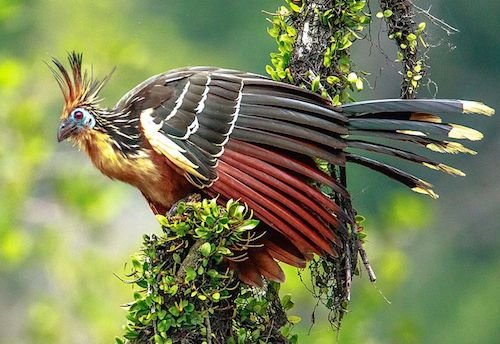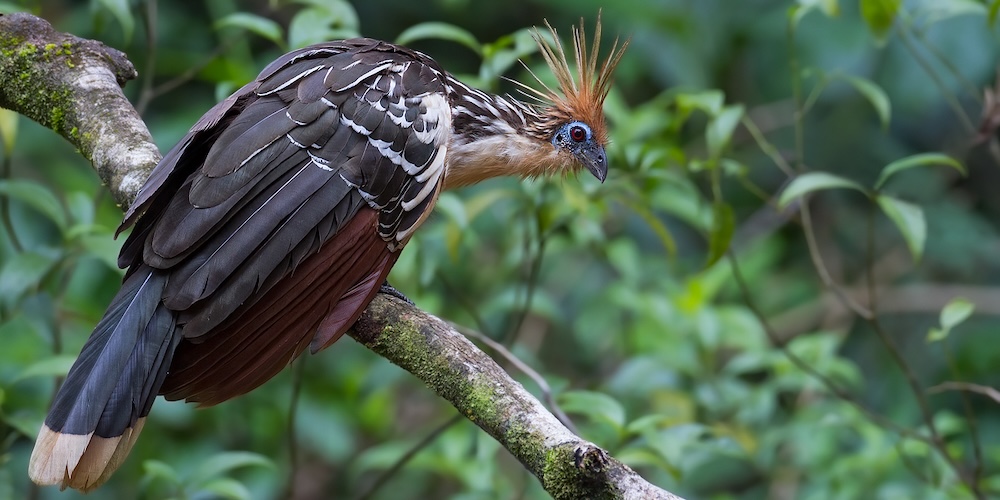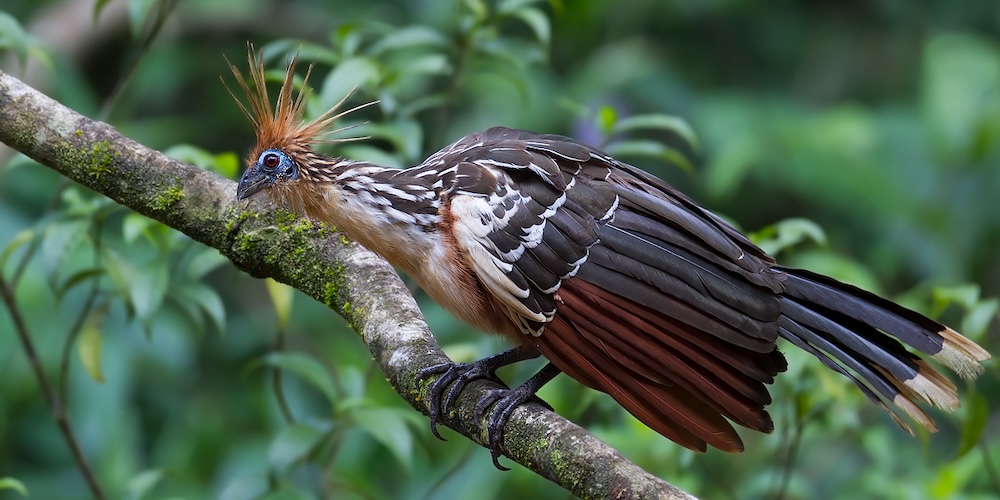Opisthocomidae – Hoatzin

The Opisthocomidae is a non-passerine family of birds, the only family within the order Opisthocomiformes. The only living representative of which is the Hoatzin Opisthocomus hoazin, which lives in the Amazon and the Orinoco deltas. Several fossil species have been identified, including one from Africa and another in Europe. It is also known as the stinkbird, or Canje pheasant, and is a species of tropical bird found in swamps, riparian forests, and mangroves of the Amazon and the Orinoco Delta in South America. It is notable for having chicks that possess claws on two of their wing digits.
It is the only member of the genus Opisthocomus – meaning ‘wearing long hair behind’, referring to its large crest, which in turn is the only extant genus in the family and order. The taxonomic position of this family has been greatly debated, and is still far from clear.
The Hoatzin is pheasant-sized, with a total length of 65 centimetres, and a long neck and small head. It has an un-feathered blue face with maroon eyes, and its head is topped by a spiky, rufous crest. The long, sooty-brown tail is broadly tipped buff. The upper parts are dark, sooty-brown-edged buff on the wing coverts, and streaked buff on the mantle and nape. The under parts are buff, while the crissum (the undertail coverts surrounding the cloaca), primaries, underwing coverts and flanks are rich rufous-chestnut, but this is mainly visible only when birds open their wings.

Hoatzin Opisthocomus hoazin – ©Dubi Shapiro

It is an herbivore, eating leaves and fruit, and has an unusual digestive system with an enlarged crop used for fermentation of vegetable matter, in a manner broadly analogous to the digestive system of mammalian ruminants. The alternative name of ‘stinkbird’ is derived from the bird’s foul odour, which is caused by this fermentation of food.
It is also a noisy species, with a variety of hoarse calls, including groans, croaks, hisses and grunts. These calls are often associated with body movements, such as wing spreading. Calls are used to maintain contact between individuals in groups; to warn of threats or intruders as well as by chicks when begging for food.
Hoatzins are seasonal breeders, breeding during the rainy season, the exact timing of which varies across its range. They are gregarious and nest in small colonies, laying two or three eggs in a stick nest in a tree hanging over water in seasonally flooded forests. The chicks, which are fed on regurgitated fermented food, have another odd feature; they have two claws on each wing. Immediately on hatching, they can use these claws, and their oversized feet, to scramble around the tree branches without falling into the water. When predators such as the Great Black Hawk attack a hoatzin nesting colony, the adults fly noisily about, trying to divert the predator’s attention, while the chicks move away from the nest and hide among the thickets. If discovered, however, they drop into the water and swim under the surface to escape, then later use their clawed wings to climb back to the safety of the nest.
This claw and behaviour has, inevitably, led to comparisons to the fossil bird Archaeopteryx, but the characteristic is rather an autapomorphy, possibly caused by an atavism toward the dinosaurian finger claws, whose developmental genetics presumably is still in the avian genome. Since Archaeopteryx had three functional claws on each wing, some earlier systematists speculated that the hoatzin was descended from it, because nestling hoatzins have two functional claws on each wing. Modern researchers believe that the young hoatzin’s claws are of more recent origin, however, and may be a secondary adaptation from its frequent need to leave the nest and climb about in dense vines and trees well before it can fly.
-
Number of bird species: 1
(As at July 2025)
Hoatzin Opisthocomus hoazin
-
Opisthocomidae
Family AccountOpisthocomidae is a family of birds, the only named family within the order Opisthocomiformes. The only living representative is the hoatzin.
-
Hoatzin Opisthocomus hoazin
Species AccountThis species is considered to have a high dependency on forest habitat, and tree cover is estimated to have declined by 11% within its mapped range over the -
Hoatzin Opisthocomus hoazin
Species AccountLarge, dumpy bird found around lake edges and slow-moving streams. Head looks too small for its large brown body. Its orange mohawk, blue facial skin, -
Hoatzin Opisthocomus hoazin
Species AccountThe hoatzin (Opisthocomus hoazin), also known as the stinkbird, or Canje pheasant, is a species of tropical bird found in swamps, riparian forests, and mangroves of the Amazon and the Orinoco Delta in South America. It is notable for having chicks that possess claws on two of their wing digits. -
Hoatzin Opisthocomus hoazin
Species AccountSound archive and distribution map.
